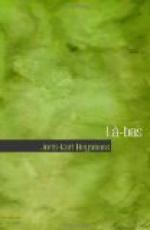“You asked me, a few seconds ago, whether these books treated of bells from the liturgical point of view. Yes, most of them give tabulated explanations of the significance of the various component parts. The interpretations are simple and offer little variety.”
“What are a few of them?”
“I can sum them all up for you in a very few words. According to the Rational of Guillaume Durand, the hardness of the metal signifies the force of the preacher. The percussion of the clapper on the sides expresses the idea that the preacher must first scourge himself to correct himself of his own vices before reproaching the vices of others. The wooden frame represents the cross of Christ, and the cord, which formerly served to set the bell swinging, allegorizes the science of the Scriptures which flows from the mystery of the Cross itself.
“The most ancient liturgists expound practically the same symbols. Jean Beleth, who lived in 1200, declares also that the bell is the image of the preacher, but adds that its motion to and fro, when it is set swinging, teaches that the preacher must by turns elevate his language and bring it down within reach of the crowd. For Hugo of Saint Victor the clapper is the tongue of the officiating priest, which strikes the two sides of the vase and announces thus, at the same time, the truth of the two Testaments. Finally, if we consult Fortunatus Amalarius, perhaps the most ancient of the liturgists, we find simply that the body of the bell denotes the mouth of the preacher and the hammer his tongue.”
“But,” said Durtal, somewhat disappointed, “it isn’t—what shall I say?—very profound.”
The door opened.
“Why, how are you!” said Carhaix, shaking hands with Gevingey, and then introducing him to Durtal.
While the bell-ringer’s wife finished setting the table, Durtal examined the newcomer. He was a little man, wearing a soft black felt hat and wrapped up like an omnibus conductor in a cape with a military collar of blue cloth.
His head was like an egg with the hollow downward. The skull, waxed as if with siccatif, seemed to have grown up out of the hair, which was hard and like filaments of dried coconut and hung down over his neck. The nose was bony, and the nostrils opened like two hatchways, over a toothless mouth which was hidden by a moustache grizzled like the goatee springing from the short chin. At first glance one would have taken him for an art-worker, a wood engraver or a glider of saints’ images, but on looking at him more closely, observing the eyes, round and grey, set close to the nose, almost crossed, and studying his solemn voice and obsequious manners, one asked oneself from what quite special kind of sacristy the man had issued.
He took off his things and appeared in a black frock coat of square, boxlike cut. A fine gold chain, passed about his neck, lost itself in the bulging pocket of an old vest. Durtal gasped when Gevingey, as soon as he had seated himself, complacently put his hands on exhibition, resting them on his knees. Enormous, freckled with blotches of orange, and terminating in milk-white nails cut to the quick, the fingers were covered with huge rings, the sets of which formed a phalanx.




